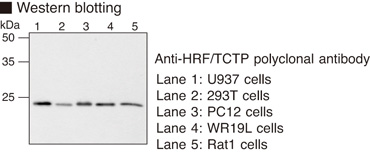Anti-HRF (TCTP) (Human) pAb
| Code | Size | Price |
|---|
| MBL-PM017 | 100 ug | £307.00 |
Quantity:
Prices exclude any Taxes / VAT
Overview
Host Type: Rabbit
Antibody Isotype: IgG
Antibody Clonality: Polyclonal
Regulatory Status: RUO
Target Species:
- Human
- Mouse
- Rat
Applications:
- Immunohistochemistry (IHC)
- Western Blot (WB)
Shipping:
4°C
Storage:
-20°C
Images
Documents
Further Information
Applications:
WB - 1:1,000 (chemiluminescence detection system) IHC - 1:1,000 (Heat treatment required for paraffin)
Background:
The pathophysiological events of human allergic disease are characterized by infiltration of inflammatory cells and by the presence of mediators such as histamine. An IgE-dependent histamine releasing factor (HRF) produced by lymphocytes of atopic children and present in biological fluids of allergic patients has been identified and purified. HRF, also known as TCTP (Translationally Controlled Tumor Protein), Fortilin, Tumor protein-1 (Tpt-1), lens epithelial protein and p23, is as a 21 or 23 kDa protein produced in a variety of mouse and human cell lines, respectively1). HRF binds to a unique species of IgE on the surface of mast cells and basophils and thereby causes histamine release. The histamine released in late-phase reaction (LPR) of chronic allergic diseases such as asthma results from activation of basophils, eosinophils and lymphocytes infiltrate tissues during this response.
Concentration:
1 mg/mL
Formulation:
This antibody is supplied in 100 ul PBS (pH 7.2) containing 50% Glycerol. Contains no preservatives.
Gene IDs:
Human: 7178 Mouse: 22070 Rat: 116646
Immunogen Translated:
Full-length recombinant human HRF
Reactivity:
This antibody reacts with HRF (23
kDa) by Western blotting.
Shelf Life:
1 year
Source:
This antibody is a protein-A sepharosepurified
rabbit polyclonal antibody raised against a
GST-HRF fusion protein corresponding to full length amino
acids of human HRF (1-172 a.a.).
Target:
HRF/TCTP
References
1) Tuynder, M., et al. Proc. Natl. Acad. Sci. USA 101,
15364 (2004)




